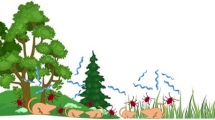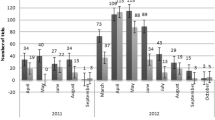Abstract
Ticks represent the primary vectors of several serious diseases, including the Lyme disease caused by Borrelia burgdorferi sensu lato (Bbsl). In this study two dominant ectoparasitic groups of arthropods (Mesostigmata, Siphonaptera) were investigated for the presence of borrelian DNA in order to determine their potential role of vectors (or carriers) of this bacterium. All individuals (235) were collected from wild-living rodents obtained in three localities in the Czech Republic (Bažantula, Baba and Křižovice). The majority of parasites were members of the families Parasitidae and Dermanyssidae (Mesostigmata) and families Hystrichopsyllidae and Ceratophyllidae (Siphonaptera). The rodent host species was almost exclusively the yellow-necked mouse (Apodemus flavicollis). Bbsl was detected by the PCR method in the following ectoparasite species: Euryparasitus emarginatus (1), Eulaelaps stabularis (1), Haemogamassus nidi (1), Laelaps agilis (5), Myonyssus gigas (1) (Mesostigmata) and Ctenophthalmus agyrtes (1), C. solutus (3) (Siphonaptera).
Similar content being viewed by others
References
Anderson J.F. 1989. Epizootiology of Borrelia in Ixodes tick vectors and reservoir hosts. Reviews of Infectious Diseases, 11, 1451–1459. DOI: 10.1093/clinids/11.Supplement_6.S1451.
Bennett C.E. 1995. Ticks and Lyme Disease. Advances in Parasitology, 36, 343–405. DOI:10.1016/S0065-308X(08)60494-7.
Daniel M., Mrciak M., Rosicky B. 1970. Location and composition of nests built by some central European insectivores and rodents in forest biotopes. Acta Facultatis Rerum Naturalium Universitatis Comenianae, 16, 1–36.
Danielová V., Rudenko A., Daniel M., Holubová J., Materna J., Golovchenko M., Schwarzová L. 2006. Extension of Ixodes ricinus ticks and agents of tick-borne diseases to mountain areas in the Czech Republic. International Journal of Medical Microbiology, 296, 48–53. DOI: 10.1016/j.ijmm.2006.02.007.
Frank C. 1977. The importance of Laelaps agilis C. L. Koch 1836 (Mesostigmata: Parasitiformae) as a vector of Hepatozoon sylvatici Coles 1914 (Sporozoa: Haemogregarinidae). Zeitschrift für Parasitenkunde, 53, 307–310. DOI: 10.1007/BF00389948.
Gern L. 2008. Borrelia burgdorferi sensu lato, the agent of lyme borreliosis: life in the wilds. Parasite, 15, 244–247.
Gray J.S. 1998. The ecology of ticks transmitting Lyme borreliosis. Experimental and Applied Acarology, 22, 249–258. DOI: 10.1023/A:1006070416135.
Hanincová K., Schafer S.M., Etti S., Sewell H.S., Tarageľov D., Labuda M., Kurtenbach K. 2003. Association of Borrelia afzelii with rodents in Europe. Parasitology, 126, 11–20. DOI: 10.1128/AEM.69.5.2825-2830.2003.
Haitlinger R. 1977. Parasitological investigation of small mammals of Gory Sowie (Middle Sudetes). VI. Siphonaptera, Anoplura, Acarina. Polskie Pismo Entomologiczne, 47, 429–492.
Halouzka J. 1993. Borreliae in Aedes vexans and hibernating Culex pipiens molestus mosquitoes. Biológia, 48, 123–124.
Hubálek Z., Halouzka J., Juřicová Z. 1998. Investigation of haematophagous arthropods for borreliae — summarized data, 1988–1996. Folia Parasitologica (Praha), 45, 67–72.
Karg W. 1993. Acari (Acarina), Milben Parasitiformes (Anactinochaeta), Cohors Gamasina Leach, Raubmilben. Die Tierwelt Deutschlands 59, Jena: Gustav Fischer Verlag, 1–523.
Kocianová E. 1989. Nest ectoparasites (gamasid mites) as vectors for rickettsia under experimental conditions. Trudy Instituta imeni Pasteura, 66, 89–94.
Krasnov B.R. 2008. Functional and evolutionary ecology of fleas. Cambridge University press, 593 pp. DOI:10.1017/CBO97 80511542688
Lindsay L.R., Barker I.K., Surgeoner G.A., Mc Ewen S.A., Elliott L.A., Kolar J. 1991. Apparent incompetence of Dermacentor variabilis (Acari, Ixodidae) and fleas (Insecta, Siphonaptera) as vectors of Borrelia burgdorferi in an Ixodes dammini endemic area of Ontario, Canada. Journal of Medical Entomology, 28, 750–753.
Literák I., Stekolnikov A.A., Sychra O., Dubská L., Tarageľov. 2008. Larvae of chigger mites Neotrombicula spp. (Acari: Trombiculidae) exhibited Borrelia but no Anaplasma infections: a field study including birds from the Czech Carpathians as hosts of chiggers. Experimental & Applied Acarology, 44, 307–314. DOI: 10.1007/s10493-008-9150-1.
Lysý J., Nosek J., Vyrosteková V., Kováčik J. 1979. Isolation of Francisella tularensis from mites Haemogamasus nidi and Laelaps hilaris in western Slovakia. Zentralblatt für Bakteriologie A, 244, 324–326.
Mačička O. 1955. O výškovom rozvrstvení kliešťa obyčajného (Ixodes ricinus L., 1758) vo Vysokych Tatrách. Zoologické a Entomologické Listy, 4, 384–388.
Magnarelli L.A., Anderson J.F., Barbour A.G. 1986. The etiological agent of Lyme disease in deer flies, horse flies and mosquitoes. Journal of Infectious Diseases, 154, 355–358. DOI: 10.1093/infdis/154.2.355.
Mašán P., Fend’a P. 2010. A review of the laelapid mites associated with terrestrial mammals in Slovakia, with key to the European species (Acari: Mesostigmata: Dermanyssoidea). Institute of Zoology, SAS, Bratislava 2010, 978-80-970406-8-0, NOI Press, Bratislava, 187 pp.
Mohamed H.A., Molyneux D.H., Wallbanks K.R. 1987. A coccidian in haemogamasid mites; possible vectors of Elleipsisoma thomsoni Franca, 1912. Annales de Parasitologie Humaine et Comparée, 62, 107–116.
Mrciak M., Daniel M., Rosicky B. 1966. Parasites and inhabitants of small mammals in the family Gamasoidea (Parasitiformes). Acta Zoologica Universitatis Comenianae, 13, 81–116.
Novák K., Povolny D. 1969. Metody sběru a preparace hmyzu. Praha: Academia Praha, 244 pp. DOI: SVK01-000313071.
Picken M.M., Picken R.N., Han D., Cheng Y., Strle F. 1996. Single-Tube Nested Polymerase Chain Reaction Assay Based on Flagellin Gene Sequences for Detection of Borrelia burgdorferi sensu lato. European Journal of Clinical Microbiology & Infectious Diseases, 15, 489–498. DOI: 10.1007/BF01691317.
Pokorny P. 1989. Incidence of the spirochete Borrelia burgdorferi in arthropods (Arthropoda) and antibodies in vertebrates (Vertebrata). Československ, 38, 52–60.
Rosicky B. 1957. Blechy — Aphaniptera. Praha: Fauna CSR, 442 pp.
Skoracki M., Michalik J., Skotarczak B., Rymaszewska A., Sikora B., Hofman T., Wodecka B., Sawczuk M. 2006. First detection of Anaplasma phagocytophilum in quill mites (Acari: Syringophilidae) parasitizing passerine birds. Microbes and Infection, 8, 303–307. DOI: 10.1016/j.micinf.2005.06.029
Stanko M., Miklisova D. 2000. Host — parasite relationships between two ectoparasites groups (Ixodida, Mesostigmata) and two rodent species in lowland ecosystem of Slovakia. In: Stawonogi Pasożytnicze i Alergogenne, Lublin: KGM, 23–36.
Stanko M., Miklisova D. 2002. Infestation trends of two rodent species (Rodentia, Muridae) on the East Slovakian Lowland. In: Stawonogi Pasożytnicze i Alergogenne, Lublin: KGM, 105–114.
Stanko M., Krasnov B.R., Miklisova D., Morand S. 2007. Simple epidemiological model predicts the relationships between prevalence and abundance in ixodid ticks. Parasitology, 134, 59–68. DOI: 10.1017/S0031182006001296.
Tagiltsev A.A. 1957. On the relationships between parasitic and nidicolous Acari. Meditsinskaya Parazitologiya and Parazitarnyye Bolezni, 26, 440–447.
Tarageľová V., Kočá J., Hanincová K., Kurtenbach K., Derdáková M., Ogden N.H., Literák I., Kocianová E., Labuda M. 2008. Blackbirds and Song Thrushes Constitute a Key Reservoir of Borrelia garinii, the Causative Agent of Borreliosis in Central Europe. Applied and Environmental Microbiology, 74, 1289–1293. DOI: 10.1128/AEM.01060-07.
Žákovská A., Nejedlá P., Holíková A., Dendis M. 2002. Positive findings of Borrelia burgdorferi in Culex (C) pipiens pipiens larva in the surrounding of Brno City determined using the PCR method. Annals of Agricultural and Environmental Medicine, 9, 257–259.
Zuevskij A.P. 1976. Role of gamasids in the epizootiology of tularemia. Parazitologiya, 10, 531–535.
Author information
Authors and Affiliations
Corresponding author
Rights and permissions
About this article
Cite this article
Netušil, J., Žákovská, A., Vostal, K. et al. The occurrence of Borrelia burgdorferi sensu lato in certain ectoparasites (Mesostigmata, Siphonaptera) of Apodemus flavicollis and Myodes glareolus in chosen localities in the Czech Republic. Acta Parasit. 58, 337–341 (2013). https://doi.org/10.2478/s11686-013-0147-5
Accepted:
Published:
Issue Date:
DOI: https://doi.org/10.2478/s11686-013-0147-5




